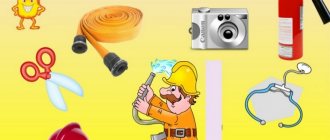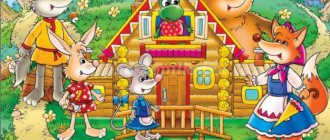Card index “Games - conversations on valeology” card index on the topic
Didactic games for preschoolers (valeology).
Perhaps, the problem of preserving the health of preschool children is one of the problematic ones if adults do not address it sufficiently. And instilling a caring attitude towards their health in children can be done using a method that children really like - this is a game. So, I present to your attention interesting didactic games for preschoolers for use both in kindergarten and at home.
1. Drawing up a model “How to protect yourself from a cold” and “How to behave during an illness”
Goal: To consolidate knowledge about disease prevention
Material: Large cards - 2 pcs. with the image of a sick child; a set of small cards with preventative measures and a set of cards with activities aimed at rapid recovery.
Progress of the game: In front of the child there are 2 large cards with the image of a sick and healthy child. The child’s task is to create a model of behavior during illness; select the desired set of cards and put them next to the card with the sick child. And also create a model of preventive actions against colds by similarly selecting the necessary ones from the available cards and putting them on a healthy child.
2. Story based on the mnemonic table “If you want to be healthy”
Goal: To consolidate children's knowledge about various factors that contribute to the preservation and strengthening of health.
Material: Mnemonic table “If you want to be healthy”
Progress of the game: On the table there is a mnemonic table “If you want to be healthy.” The teacher asks you to use a mnemonic table to tell you what you need to do to be healthy. The child’s task is to correctly talk about the factors that promote health, using the mnemonic table, without making mistakes.
3. Didactic game “To be healthy, I will...”
Goal: To consolidate children's knowledge about leading a healthy lifestyle.
Material: Subject pictures depicting various positive situations (barefoot walking, sunbathing, sledding, dousing, etc.) and a set of pictures with negative situations.
Progress of the game: The teacher says: “To be healthy, you will...” The child’s task is to complete the first part of the teacher’s sentence and select the corresponding positive story picture.
4. State of the model “Factors that promote health”
Goal: To consolidate children’s knowledge about factors that help improve health
Material: Large sheet with a picture of a person in the center. Colored pencils.
How to play: In front of the child lies a large sheet with a picture of a person in the center. The child’s task is to draw around the person everything that helps improve human health (vitamins, sports, etc.)
5. “Helpful - harmful”
Goal: To consolidate children’s knowledge about the benefits and harms of certain products
Material: Large cards with the image of a cheerful man; a set of cards depicting foods that are healthy and harmful to human health.
How to play: There are 2 large cards on the table with the faces of a cheerful and sad man. The child’s task is to choose cards with products that are good for human health and put them on the card with a cheerful little man, and put cards with products that are harmful to human health on the card with a sad little man.
6. Didactic game on valeology “We are tempering”
Goal: To consolidate knowledge about subjects that help us harden.
Material: Cards depicting items needed for hardening (inventory).
How to play: Children take turns taking a card with a picture of an item needed for hardening. The child’s task is to tell about the purpose of the object and its benefits for hardening the body.
7. “Brew borscht”
Purpose: To give children an idea of how to prepare soup, to consolidate knowledge about vegetables and fruits.
Material: Sets of pictures depicting the products needed for borscht.
Progress of the game: Children take turns choosing the appropriate subject pictures depicting products for preparing borscht.
8. “A lot is a little”
Goal: To teach children to think about what and in what quantities they can consume without harming their health. To develop the ability to classify foods: sour - sweet, bitter - salty, vegetables - fruits.
Material: Pictures depicting vegetables, fruits; card with questions:
Progress of the game: What happens if you eat a lot (picture)?
Eating a lot of apples is good...
Eating too many apples is bad.
Task: arrange vegetables and fruits, “tops and roots.”
9. Didactic game on valeology “Vitamin Summer”
Goal: To consolidate knowledge about vitamins and their content in foods.
Material: Large cards (3 pieces) and 32 small cards with images of vegetables and fruits.
Progress of the game: The teacher names vitamins on a large card, and children choose object pictures depicting products that contain this vitamin and put them next to the corresponding vitamin.
10. Didactic game “Magic Pan”
Goal: Expand the understanding of the variety of dishes.
Material: Image of a pan and cards with images of ready-made dishes and the products from which they were prepared.
Progress of the game: Each child is given a card with a picture of a finished dish. The child’s task is to select an object picture with the necessary products for preparing a given dish. Those who complete the task put their pictures in the magic pan. Everyone checks the correct execution together.
11. Didactic game “Guess the sport”
Goal: To consolidate children's knowledge about different sports.
Material: Cards depicting attributes for each sport.
Progress of the game: The presenter gives the children cards depicting various sports. The child’s task is to select cards with the appropriate attributes for a given sport.
12. Didactic game “Dress the Athlete”
Goal: To teach children the ability to select appropriate equipment and equipment for athletes
Material: Card with images of equipment and equipment of different athletes
How to play: Children are given cards depicting athletes from various sports. The child’s task is to select pictures with the appropriate equipment and equipment for a given athlete.
13. Didactic game: “Healthy and unhealthy food.”
Goal: To form children’s knowledge about healthy and unhealthy food, to systematize children’s ideas about the functioning of the digestive tract,
develop healthy eating principles.
14. Didactic game: “My body”
Goal: To form an idea of the structure of the body and the muscular system,
to develop the ability to move beautifully and accurately, to cultivate a conscious attitude towards physical education classes and towards one’s own health.
15. Didactic game: “Why did this happen? »
Goal: To form the concept of first aid for sunstroke, heatstroke, fainting, insect bites, bleeding, fractures, poisoning, to introduce artificial respiration techniques, its meaning and necessity.



